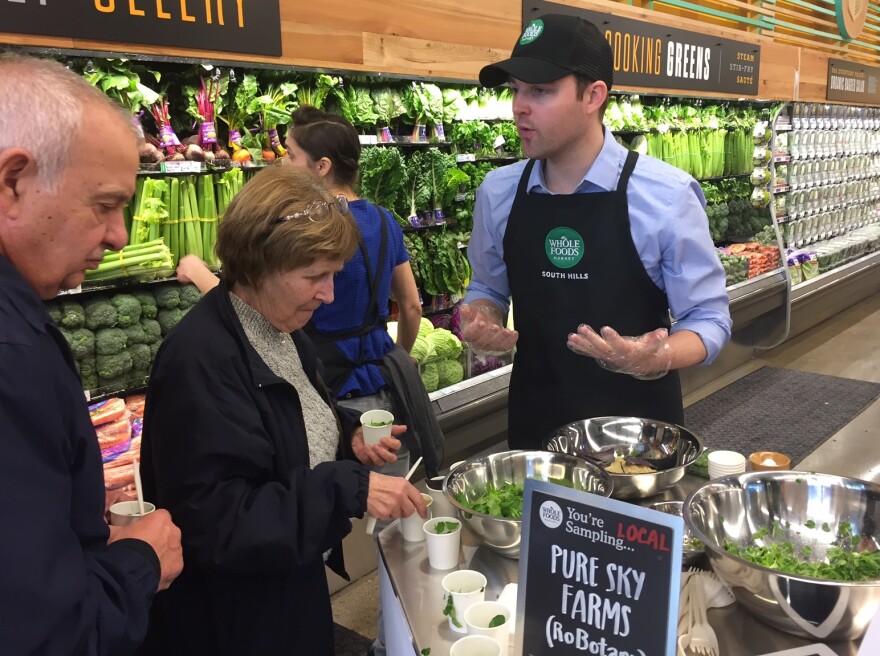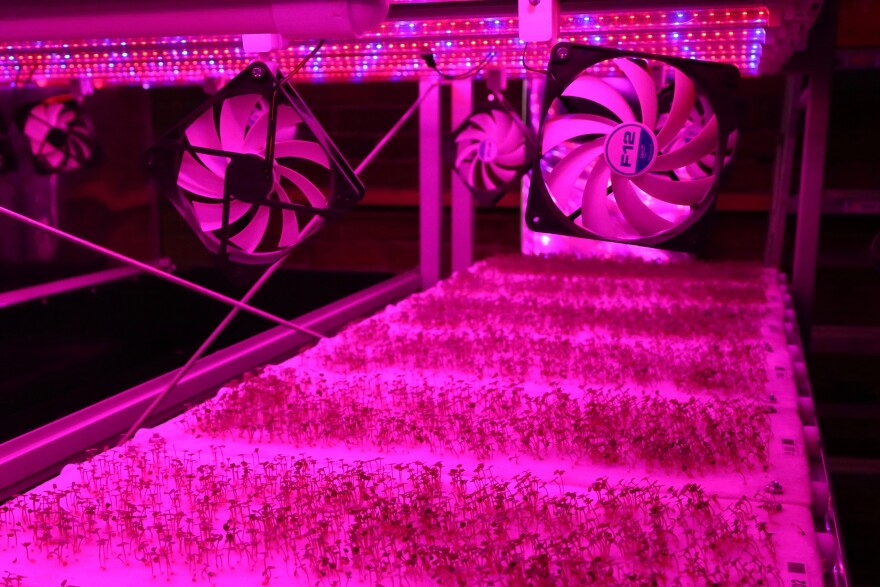Pure Sky Farms CEO Austin Webb wore a black apron over his dress shirt as he served samples to costumers at the grand opening of the new Whole Foods Market in Upper St. Clair in January.
“This is micro and petite arugula that we have right here, covered in olive oil and lava salt,” he told a customer. “Then we have cilantro with a tortilla chip.”
The customer opted for the arugula, which Webb explained was harvested that very morning.

The greens and herbs Pure Sky Farms was offering were grown less than 10 miles away, inside an office building in Oakland. That’s where Pure Sky Farms’ parent company, RoBotany, is headquartered. The Carnegie Mellon University spinoff develops robotics and data analytics for vertical indoor farming.
The concept of vertical farming has been around for more than a century. The idea is to grow a lot more food with a lot less space, water and waste. Plants are grown in trays that are stacked vertically, sometimes several stories tall.
“The roots are hanging down below the trays basically suspended in air and then they get the nutrient rich water which replace soil,” Webb said.
Every 10 minutes, the misters kick on for two-and-a-half seconds. Blue and red LEDs provide just the right color of light to optimize growth.
As high-tech as all this sounds, it’s fairly standard for the vertical farming industry. But Webb said there’s still one part of the process ripe for automation.
“A lot of what you see out there is a lot of folks growing manually,” Webb said. “If they're going 25 or 30 feet in the air they're using ladders and scissor lifts to go up and get the plants.”
RoBotany is developing robots that do the work humans are currently doing, which Webb said will be a huge space saver.

In addition to robots, the company is developing data analytics that will help them optimize for nutrition and taste. Webb noted that traditional farmers often have to optimize for pest resistance and shelf stability, but Pure Sky greens will be grown indoors and harvested the same day they’re put on grocery store shelves.
“It’s a lot cooler to be able to optimize for the nutrients and the taste of a plant and be focusing on if you really want sharp tasting cilantro or mild cilantro,” Webb said.
RoBotany’s current prototype is a much smaller version of what they hope to soon build. Its footprint is just 50 square feet, and they can produce about one pound of greens a day. Because this version is so small, they don’t actually need to use the robots they’ve built to place the trays of seedlings and move them back down to ground level when it’s time to harvest.
But with a 2,000 square footprint, RoBotany’s version two protoype will allow the team to further test their technology. It will be housed in the same South Side warehouse where the company plans to build its full scale, 20,000-square-foot farm.
What will make their farm different than existing vertical farms is that they won’t need aisles wide enough for scissor lifts or even for people. They won’t really even need humans to interact with the plants at all between germination and harvest.

Webb said this is the future of farming and envisions automated indoor farming increasingly supplementing traditional farming. But he said there are still a lot of issues to figure out. Right now, most indoor vertical farms focus on greens and herbs, because they’re pretty hardy and don’t grow very tall. Growing grain, a staple in human and livestock diets alike, is a much bigger challenge.
It’s also important to note that the vertical farming industry doesn’t directly address the biggest problem with current food systems.
“We don’t actually have a food shortage worldwide,” said Tony Miga, master of sustainability at Chatham University’s Eden Hall campus. “It is not a supply issue, it’s a distribution issue.
Miga said the biggest problem with current food systems is access, on both a global and local level. But he said urban agriculture, made greener and more efficient by companies like RoBotany, does have a role to play.
“I think it's finding ways to empower communities to be able to produce their own food at some level,” Miga said.
Webb said ideally, his company’s technology could be used to bring fresh produce to food deserts. But the company is still in its infancy, and right now they’re focused on scaling up production, and bringing hyper local produce to Pittsburgh shoppers. Pure Sky Farms' produce is planned to hit Whole Foods South Hills shelves later this month.
Webb said a future goal is to create Pure Sky Farms franchises, with local owners using RoBotany’s technology to bring fresh produce to customers across the country.
In this week's Tech Headlines:
- University of Pittsburgh officials said the school will open a Master of Science in Sustainable Engineering program this summer. The major will utilize, what the school calls “a systems-based approach to help students identify and address complex environmental and socioeconomic problems.” Co-director Eric J. Beckman said, “Industry, government and non-profits are looking for the triple bottom line of social, environmental and financial success."
- According to a new report from Accenture, public sector agencies must adopt emerging technologies – including machine learning, artificial intelligence and biometrics – to attract and retain more technically adept employees. Without the refocusing of priorities the report says the gap between the private and public sector workforces will grow. Accenture surveyed nearly 800 public service technology professionals across nine countries to identify emerging technologies being implemented or piloted.
The Associated Press contributed to this report.




